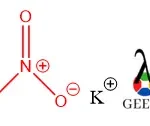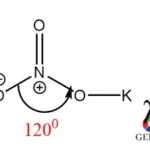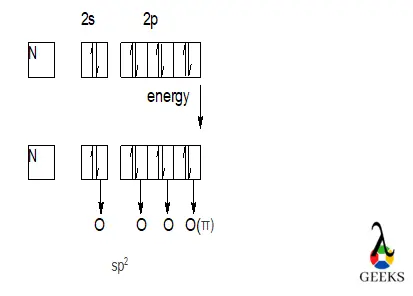KNO3 is one of the oxidizers in rocket fuel having a molar mass is 101.1032 g/mol. Let us explain in brief the KNO3 lewis structure and the other facts in brief below.
KNO3 lewis structure resembles nitrate. The counter cation of nitrate can be thought of as potassium cation, which is connected with one of the O atoms, not with the central N atom. So, the rest of the bonding and hybridization on the N center remains the same as the N atom is sp2 hybridized.
In the trigonal planar shape of KNO3, one oxygen atom is connected through a single bond with N, as well as K, and the other O atom bears a negative charge on it. Let us focus on some important facts about KNO3 like lewis structure, valence electrons, and hybridization in the following section with proper explanations.
1. How to draw the KNO3 lewis structure
KNO3 lewis structure can give the idea of bonding of the molecule, valence electrons, and availability of electrons. Let us try to draw the KNO3 lewis structure in a few steps.
Counting the total valence electrons –
First, we need to calculate the total valence electrons for KNO3. So, we have to count the valence electrons for the individual atoms and then added them together. So, the total valence electrons present within the KNO3 lewis structure is 1+5+(6*3) =24. As there are three O atoms present.
Selection of central atom –
Now choose the atom that will play the central atom for the KNO3 lewis structure. The deciding factor of a central atom is the size of the atom as well as electronegativity. The atomic radius of N is bigger than O, and N is more electropositive than O also. So, N is chosen here central atom.
Satisfying with the octet rule –
Here we should check whether all the atoms obey the octet rule or not by accumulating eight electrons in their valence shell. The electrons required will be 2+8+8+8+8 = 34. The total number of valence electrons is 24. So, the required number of bonds in KNO3 will be, ½(34-24) = 5 bonds.
Checking the valency –
In this step, we joined each and every atom with the central atom by the required number of bonds. Here the required number of bonds is 7, but the total number of atoms is 5 so we add multiple bonds to satisfy the valency of respective atoms. A double bond is present between N and one of the O atoms.
Assign the lone pairs –
In the last step after satisfying the valency of respective atoms, we assign the lone pairs which are extra valence electrons present in the valence shell. In this molecule, O atoms contain only lone pairs.
KNO3 lewis structure shape
Every molecule has its own particular shape and it depends on the VSEPR theory. KNO3 has also a geometric shape. Now we can discuss the KNO3 structure shape in detail.
The particular shape of the KNO3 molecule is trigonal planar. This shape is supported by the AX3 type molecule. N is present in the center of the trigonal and three O atoms are present in three different vertices of the geometry. This shape is perfect for KNO3 to avoid any type of repulsion.

According to the VSEPR theory, AX3-type molecules adopt trigonal bipyramidal or planar shape. Here later is the best fitter for KNO3. K atom is directly not attached to the central atom, rather it is connected to one of the O. So, K has no contribution in that kind of shape, it is around central N only.
KNO3 valence electrons
The number of electrons involved in the bond formation that are present in the valence orbital is known as valence electrons. Now discuss in detail for KNO3 molecule.
KNO3 molecule has 24 valence electrons. K has 1, N has 5 and each O atom has 6 valence electrons as they belong to groups IA, V, and VIA respectively in the periodic table. Thus, their valence shell electronic configuration will be [Ar]4s1, [He]2s22p3, [He]2s22p4 for K, N, and O respectively.
Now calculate the overall valence electrons present in the KNO3 lewis structure
- Valence electrons for one K atom = 1
- Valence electrons for one Nitrogen atom = 5
- Valence electrons for three O atoms = 6*3 = 18
- So, the total number of valence electrons present in the KNO3 lewis structure is, 1+5+18 = 24
KNO3 lewis structure lone pairs
Lone pairs are the non-bonded electrons present in the valence orbital of respective atoms. Let us talk about which atom contains lone pairs in the KNO3 molecule.
There are a total of 7 pairs of lone pairs present in the KNO3 molecule. All the lone pairs belong to only O atoms. Because all the valence electrons of the N atom are being used in the bond formation and there are no non-bonded electrons are available. O is from group 16th element and has lone pairs.
Each O atoms contain a different number of lone pairs. Now calculate the lone pairs.
- O atoms have two lone pairs who are double bonded with N
- Another O has also two lone pairs that are connected to the K site.
- A negative charge containing O atoms has three lone pairs.
- So, the total lone pairs = 2+2+3 = 7 pairs.
KNO3 lewis structure formal charge
The formal charge can predict the charge in a molecule that can appear on a particular atom. Now we calculate the formal charge of individual atoms of the KNO3 molecule.
The formal charge on KNO3 is not zero. Because one of N and O are charged and share a partial ionic bond. So, that amount of charge can be predicted by the formal charge. Calculating formal charge we have to assume that N and O both have the same electronegativity.
The formula we can use here, F.C. = Nv – Nl.p. -1/2 Nb.p.
The formal charge over,
- N = 5-0-(8/2) = +1,
- double bonded O = 6-4-(4/2) = 0,
- K-bonded O = 6-4-(4/2) = 0,
- the last O = 6-6-(2/2) = -1
So, the molecule is neutral as the negative and positive charges can neutralize the charge effect.
KNO3 lewis structure octet rule
Every atom follows the octet rule via completing its valence orbital after the formation of a covalent bond. KNO3 octet rule will be discussed below.
K, N, and O complete their valence orbital by bond forming and sharing electrons with a suitable number of electrons. The electronic configuration of K, N, and O are [Ar]4s1, [He]2s22p3, and [He]2s22p3 respectively. So, they need one, three, and two electrons respectively.
K is an s block element so it needs one more electron to complete its octet and it shares a bond with the O atom. The central N needs three more electrons and it formed three bonds with three O to complete the octet. Every O atom completes its octet by sharing electrons in covalent bonds.
KNO3 bond angle
Every molecule has its own bond angle in between the central and surrounding atoms for proper orientation of the arrangement. Let’s discuss the KNO3 bond angle in brief.
The bond angle of KNO3 is 1200, which perfect bond angle for a trigonal planar molecule. So, it is clear that there is no repulsion or steric crowding present for deviation of the angle. The value of this bond angle in between O-N-O moiety. The value of angle also interns the hybridization of central N.

The bond angle for an AX3 type molecule is 1200 for a trigonal planar. The value deviates only when there is any steric crowding present between atoms and lone pairs. But in the KNO3 molecule, three O atoms are far away from each other so there is no chance for crowding and the bond angle remains the same.
KNO3 lewis structure resonance
Delocalization of electrons cloud via the different canonical forms is known as resonance. How delocalization of electrons occurred in the KNO3 molecule is discussed below.
Resonance occurred in the KNO3 molecule from the electron-rich O center to the electron-deficient N site. O carries a negative charge so it has enough electron clouds for delocalization via the different canonical forms of the molecule. The molecule is planar so the resonance occurs in a very easy way.

All three structures are different canonical forms of the KNO3 molecule. I and II are similar and they have more contribution to the resonance as they have more stability. Because they have more number of covalent bonds and a negative charge on the electronegative atom. Structure III is the least stable.
KNO3 hybridization
To make a covalent bond having different energized orbitals undergo hybridization to form an equivalent hybrid orbital. Now discuss the hybridization of KNO3 in detail.
The central N is sp2 hybridized because the number of orbitals involved is 3.
| Structure | Hybridization value | State of hybridization of central atom | Bond angle |
| Linear | 2 | sp /sd / pd | 1800 |
| Planner trigonal | 3 | sp2 | 1200 |
| Tetrahedral | 4 | sd3/ sp3 | 109.50 |
| Trigonal bipyramidal | 5 | sp3d/dsp3 | 900 (axial), 1200(equatorial) |
| Octahedral | 6 | sp3d2/ d2sp3 | 900 |
| Pentagonal bipyramidal | 7 | sp3d3/d3sp3 | 900,720 |
Why and How KNO3 is sp2 hybridized?
If the central atom of any molecule is involved in three orbitals in the hybridization and only forms a sigma bond then it will be sp2 hybridized.
The formula used for the hybridization is, H = 0.5(V+M-C+A), where H= hybridization value, V is the number of valence electrons in the central atom, M = monovalent atoms surrounded, C=no. of cation, A=no. of the anion. So, the hybridization of central N in KNO3 is, ½(5+0+0+1) = 3(sp2)

We only consider the sigma bond in the hybridization, not the π or any kind of multiple bonds. This is the limitation of hybridization. All the O atoms are directly attached to central N so they are involved in the hybridization, not the K, as it is connected with one of the O atoms.
KNO3 molar mass
Molar mass is the exact mass of the molecule including its individual atoms’ molar mass. Let’s calculate the molar mass of KNO3.
The molar mass of KNO3 is 101.1032 g/mol. This value comes from the individual atoms’ molar mass and summation value. The molar mass is always defined in the g/mol. It is defined that how many grams of the molecule are present per mol.
Why and how the molar mass of KNO3 is 101.1032 g/mol?
This exact value comes from the summation of an individual atom’s atomic mass value. Now calculate each molar mass separately.
- The atomic mass value of K is 39.0983
- The atomic mass of N is 14.0067
- The atomic mass of O is 15.999
- Now there are three o atoms are present, so the molar mass of the KNO3 molecule is, 39.0983 + 14.0067 + (15.999*3) = 101.1032 g/mol.
- The calculation is done for 1 mol of the composition
So, from the above calculation, we can conclude that there are 101.1032 g of KNO3 is present in 1 mol. So, for a 1:1 reaction of KNO3 and any other molecule we have to take 101.1032 g of KNo3 molecule.
Is KNO3 an electrolyte?
When a molecule is ionized in water and conducts electricity then it should be called an electrolyte. Now see whether KNO3 is an electrolyte or not.
KNO3 is an electrolyte. It can conduct electricity in its aqueous solution. The mode of electricity passed is not so high so it behaves as a moderate electrolyte. KNO3 is a salt and every salt is an electrolyte.
Why and How KNO3 is an electrolyte?
KNO3 can be ionized in the aqueous solution to carry electricity.
KNO3 is electrolyte because it ionized in the form of K+ and NO3– in the aqueous solution. The mobility of K+ is so high due to ionic charge and also nitrate is a better electric conductance anion, as there is resonance presence with the nitrate and electronegative O atoms are present.
So, when KNO3 is dissolved in the aqueous solution it is ionized to form the respective cation and anions. For this reason, the solution becomes charged and carries electricity, so KNO3 can behave as an electrolyte.
Synthesis KNO3 lewis structure
KNO3 is a white-colored crystalline solid salt in its physical state. Boiling point, as well as melting point, is very high about 653 K and 607 K respectively.
- The synthetic method of preparation of KNO3 is combining ammonium nitrate with potassium hydroxide.
- NH4NO3(aq) + KOH(aq) = NH3(g) + KNO3(aq) + H2O(l)
- Another process is without forming ammonia as by product, reacting ammonium nitrate with potassium chloride.
- NH4NO3(aq) + KCl(aq) = NH4Cl(aq) + KNO3(aq)
KNO3 has an orthorhombic crystal structure in its lattice form and at higher temperatures, it changes to trigonal.
Conclusion
KNO3 molecule is a strong electrolyte molecule, its aqueous solution conducts electricity. It is a covalent molecule having partially charged.
Also Read:
- Mgs lewis structure
- Sro lewis structure
- Gai3 lewis structure
- F2 lewis structure
- Brcl5 lewis structure
- Bcl3 lewis structure
- Ch3oh lewis structure
- Al3 lewis structure
- Clo2 lewis structure
- Mg2 lewis structure

Hi……I am Biswarup Chandra Dey, I have completed my Master’s in Chemistry from the Central University of Punjab. My area of specialization is Inorganic Chemistry. Chemistry is not all about reading line by line and memorizing, it is a concept to understand in an easy way and here I am sharing with you the concept about chemistry which I learn because knowledge is worth to share it.